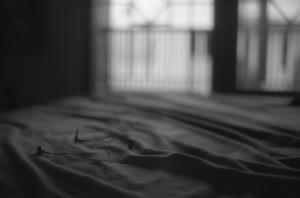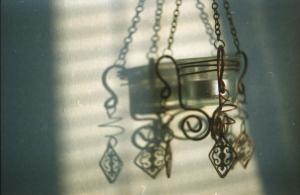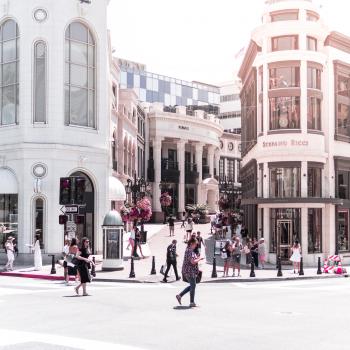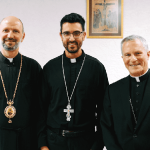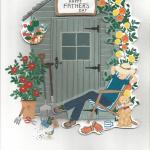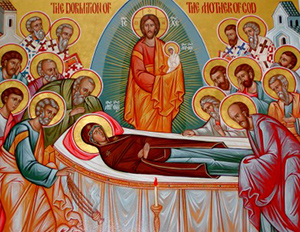 Today is the Feast of the Dormition (the “falling asleep”) of the Mother of God. It is the analogue in the Eastern Orthodox Church of the Assumption of the Virgin in Roman Catholicism, and on balance, the similarities between the two commemorations are greater than their differences: The Dormition is one of the twelve Great Feasts in the Orthodox year. The Assumption is a holy day of obligation and, I am told, is superseded only by Easter in its importance for Catholics.
Today is the Feast of the Dormition (the “falling asleep”) of the Mother of God. It is the analogue in the Eastern Orthodox Church of the Assumption of the Virgin in Roman Catholicism, and on balance, the similarities between the two commemorations are greater than their differences: The Dormition is one of the twelve Great Feasts in the Orthodox year. The Assumption is a holy day of obligation and, I am told, is superseded only by Easter in its importance for Catholics.
The heart of the feast remains the same for both: the end of Mary’s earthly life of faithfulness, the culmination of her own original yes in her agreement to bear the Son of God in the reception of her sanctified body into heaven. It is believed (contrary to some popular misunderstanding) by both Orthodox and Roman Catholics that Mary experienced a normal, natural death, but received upon her burial the glorified state—reunion of body and soul—that is the ultimate end for which all we faithful pray.
In their aesthetic emphasis, though, the two feasts are utterly different: In all the Roman Catholic portrayals of the event that I have seen, Mary is bright-faced and young—evoking the description of the woman “clothed with the sun” from Revelation.
On the rich, glowing portrait that backs the altar of St. Mary of the Assumption in Govans, Baltimore, where my in-laws are parishioners, she is crowned with flowing hair that echoes the undulations of her robe as she is borne heavenward.
On the apron of concrete that tops the postconciliar mega-modern (built 1968) Faith Community of St. Mary in Landover Hills, Maryland, a couple of miles from my house, the Assumption is presented in bas relief, with the Blessed Virgin’s feet treading on billowing clouds that always remind me, paradoxically, of the cover of the 1965 Herb Alpert album Whipped Cream and Other Delights.
In comparison with all that frothy lightness—and I say this as a woman married to a Catholic, with Catholic images of Mary in my house as well as Orthodox ones—the Orthodox icon of the Dormition is weighty and grave.
It is suffused with that characteristically Orthodox emotion that others have termed bright sadness, an overwhelming joy in sorrow, in the dichotomy between the Now-and-Not-Yet, the Kingdom her son ransomed, but which has not culminated in its final fulfillment.
Here the Mother of God dances not on clouds, but lies flat on a heavily-covered bed, echoing the icon of her own mother, St. Anna, when she brought forth baby Mary in childbirth. Just as Anna was, Mary is not a young woman here, but has the covered hair of a matron and a face that looks lined and resigned to me, though that just might be my misperception of certain conventions of iconography.
Lying on her deathbed, Mary is surrounded by the flock of Apostles, who according to one tradition were all made miraculously present at the event, with (for some reason) the exception of Thomas.
The tableau is thus oddly earth-centered, which seems fitting to me, given that it rests on the oblique line of the Church’s extra-biblical tradition: This is a scene I can truly and utterly believe, whether it is in the Bible or not, and I cannot look at the icon of the Dormition without thinking of, and praying for, my own mother, lying on her deathbed and gasping for breath in the pulmonary unit at Inova Fairfax Hospital.
That my mother, with her sorrows, could be mothered by the Mother, who in her own sorrow and obedience and incomprehensible vigilance can witness for all of us before the Bright Throne.
And we, both male and female, must be about the very business of witnessing for God to each other: For it is not just women who are called to be like the Virgin Mary—
It is all of us Christians.
Mary—the Theotokos, the god bearer, as Orthodox call her—is both the literal and symbolic uniting of heaven and earth, and we, too, must follow in her steps.
The tradition is that when Thomas finally made it back to Jerusalem after Mary’s death, the stone from Mary’s tomb was rolled away and the inside was revealed to be empty. She who had borne the universe inside her had been borne away to it.
Or as we sing in the Kontakion hymn of the feast:
Neither the tomb, nor death could hold the Theotokos,
Who is constant in prayer and our firm hope in her intercessions.
For being the Mother of Life,
She was translated to life by the One who dwelt in her virginal womb.
In some icons of the Dormition, Christ descends from the top of the frame amid the shining almond of a mandorla, a sign that the events depicted therein can only be spiritually perceived. In his arms, he carries a swaddling-wrapped female baby that is said to represent Mary’s soul.
I look at that tiny baby, and think of my own little daughter when she was born, and Christ lifting up my mother’s soul, and I think that little icon baby is the ultimate objective correlative for all the thinking and psychoanalysis I’ve done in my years on this earth, the end goal to which all of us should aspire. That we might, like our model Mary, be gathered, lifted, and transformed.



